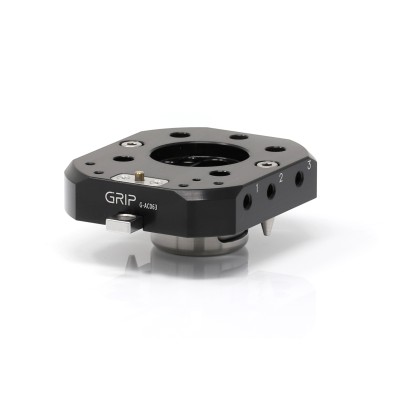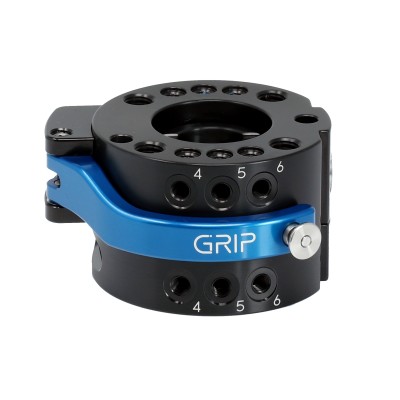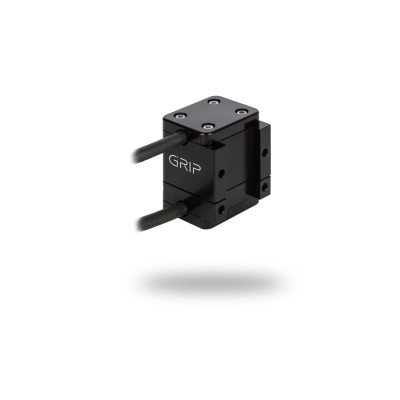GRIP handling technology
Modular gripper systems and tool changers that fit easily
A system that keeps pace
Pace is important in every production line. The faster a robot grips, changes, and continues working, the more stable the processes are and the more predictable the results become. GRIP Handling Technology supplies modular gripper systems and robot tool changers that integrate into existing systems and work reliably from day one. The components are robust and precise. They can be converted in a short time, hold positions with repeatable accuracy, and keep your system running at full speed. This creates a system from just a few building blocks that fits today and grows with your requirements tomorrow.
Why GRIP
GRIP relies on standardized interfaces that allow grippers, changers, and accessories to work together like a modular system. You can combine modules as needed, replace individual parts later, or expand step by step. This reduces setup times, keeps output stable, and makes costs predictable. The technology is compatible with common robot brands such as UR, Fanuc, and Elite Robots, and matching mounts make installation easier. In practice, this means less downtime, quick commissioning, and a solution that works reliably even in mixed robot fleets.
GRIP connects what needs to work together
The system follows a simple principle. The base carrier, gripping module, tool changer, and accessories have matching mounts that can be quickly connected. This reduces assembly time and keeps the solution lean. A change takes only a short time, after which the system continues to run with the same positions. Manual changers are the quick choice when an operator changes formats. Automatic changers take over the changeover during the process and maintain the cycle time because no intervention is necessary. Both variants fit into the same interface logic. Sensors report the status to the control system. Pneumatic and electrical signals run through matching feed-throughs. This results in tidy cable management that facilitates service and expansion.
Because every module fits
In practice, what counts is how well the modules work together. The GRIP modular system ensures that grippers, changers, and accessories fit together right from the start. This saves time during commissioning and ensures reliable cycles during operation.
Tool changers that keep pace
Manual systems are suitable for planned changes with little effort. Automatic changers take over the change directly in the process. Both variants lock securely and remain rigid. This ensures that the positions are correct, the robot's movements remain smooth, and the line runs stably.
Grippers that fit the task
Not every application can be solved with the same gripper. GRIP offers different variants for different component geometries, materials, and gripping tasks. Parallel grippers grip in a controlled manner from two sides, angle grippers move at an opening angle, and pincer grippers enclose the part flexibly. Depending on the task, you select the appropriate gripper and match the inserts to the surface and shape. Sensitive parts remain undamaged, quality remains consistent, and subsequent changeovers are successful without much effort.
Accessories that bring everything together
A good handling system is not only created by grippers and changers, but also by the right accessories. Centering sleeves align the modules precisely and ensure that every connection fits. Stop plates define precise positions in the process and provide stability for the system. Adapters connect the robot flange to the module and make integration easy. Sensors reliably transmit the status to the control system. Energy supply systems keep hoses and cables where they are needed without hindering movement. The result is a well-designed structure that can be quickly assembled.
Technically sophisticated down to the last detail
All interfaces are based on common robot standards. You can select the pneumatic and electrical connections to suit your application. The mechanics remain light and stable at the same time. Their high rigidity ensures precise movements, while their low weight keeps the cycle rate high.
The form-fitting lock closes reliably and holds even after many cycles. Maintenance and inspection are quick and easy because the design and access are clearly defined.
Manual or automatic? How to make the right choice
Manual changers are suitable for infrequent or clearly planned changes. They are easy to operate and offer a cost-effective entry point.
Automatic changers show their strength in frequent format changes during the running process. They lock securely, perform the change independently, and minimize intervention. Those who start small can start manually and convert later. Those who aim for maximum cycle rates should go straight for the automatic solution.
Three practical examples
Packaging
A robot picks up standardized trays from the conveyor belt and places them precisely in position. A parallel gripper performs this task quickly and reliably. Changing formats is a simple matter, as a manual changer separates the gripper from the robot without the need for tools. Sensors detect every movement and send feedback to the control system. This means that the system remains adaptable, even if products or processes change at short notice.
Special machine construction
When loading and unloading a CNC machine, every centimeter counts. An angle gripper securely grips the workpiece in a tight position. As soon as machining starts, the robot moves to the change station. There, an automatic tool changer releases the current gripper and transfers the next one. The exchange runs in the background without intervention and keeps the cycle time stable, even with frequently changing components.
Electronics assembly
Sensitive circuit boards require a delicate touch. A parallel gripper with soft inserts protects the sensitive surfaces when gripping. A guided energy supply brings pneumatic and signal lines safely to the gripper without tilting. Sensors reliably report position and status. The combination works quietly, accurately, and with repeatable precision and is ideal for long-term precision.
Compatibility and integration
GRIP handling technology can be combined with many common robot brands such as UR, Fanuc, and Elite Robots. The modules use standardized mounts. This simplifies installation and keeps documentation clear. Preconfigured sets for pneumatics and signal technology ensure that the system starts up faster and runs smoothly. Subsequent adjustments can also be made without much effort. The system remains flexible, even when processes change.
GRIP selection guide in five steps
The first step is to define the task. Clearly describing the task will help you find the right solution more quickly. Proceed step by step and record the most important data. First, describe the workpiece. Note down the shape, dimensions, weight, surface, and possible gripping points. This will determine how the gripper is positioned and how much force is required. Next, consider the process. What is the planned cycle time, how much space does the robot have for movement, and what environmental influences play a role? Dust, humidity, or temperature can influence the selection. In the third step, select the gripper. Parallel grippers are suitable for precise pick-ups. Angle grippers and pincer grippers solve special positions and difficult geometries. Inserts made of soft material protect sensitive surfaces. Now you decide on the changeover principle. For infrequent format changes, a manual changer is sufficient. For frequent changes during the running process, an automatic changer is recommended, which keeps the cycle time and avoids intervention. Finally, add the appropriate accessories. Centering sleeves secure the position, stop plates define end positions, and adapters connect to the flange standard of your robot. Sensors report statuses to the control system, and power supplies reliably supply grippers and changers.
The five steps at a glance:
- Define the workpiece: geometry, weight, surface, gripping points.
- Check the process: cycle time, movement space, environment.
- Select gripper: parallel, angle, or tongs with suitable inserts.
- Define change principle: manual for infrequent changes, automatic for high frequency.
- Add accessories: centering sleeves, stop plates, adapters, sensors, power supply.
Advantages for integration, conversion, and service
GRIP handling technology is designed for well-thought-out processes. All modules follow a uniform structure. This allows them to be quickly assembled and neatly integrated. This speeds up commissioning and ensures a stable start for your system. If requirements change, you can adapt the system specifically. Individual components can be replaced without changing the entire setup. This saves time and makes conversions predictable. Everything remains clear even during operation. The uniform structure facilitates maintenance, training, and spare parts supply.
GRIP handling technology configured to suit your needs
This is how consulting for GRIP handling technology works at Klefinghaus: You tell us your task. We tell you which modules are suitable. A team from automation, service, and control technology checks the workpiece, cycle time, environment, and robot interface. Then we put together grippers, tool changers, and accessories so that everything works and fits your system. You get a preconfigured solution that is easy to install. If you have any questions, we will support you on site or by phone. We are also there for you after commissioning. Spare parts, upgrades, and service are clearly regulated.
Mit Klefinghaus sind Sie gut aufgestellt
Klefinghaus begleitet Sie bei Planung, Auswahl und Integration. Sie haben eine feste Ansprechperson, die alle Schritte koordiniert. Das spart Zeit, sorgt für Übersicht und macht den Prozess verlässlich. Wir liefern GRIP Handhabungstechnik passend zu Ihrer Roboterschnittstelle. Auf Wunsch ergänzen wir FESTO Komponenten und andere passende Markenlösungen. Alles kommt aus einer Hand und lässt sich direkt kombinieren. Auch im laufenden Betrieb bleiben wir erreichbar. Bei Fragen, Ersatzteilen oder Erweiterungen finden Sie schnell die richtige Unterstützung.
FAQs about GRIP Handling Technology
What does GRIP Handling Technology stand for?
For modular gripper systems and robot tool changers that are easy to integrate. GRIP offers automatic and manual changing systems, standardized feedthroughs, and pneumatic grippers such as parallel grippers for robots. The goal is a modular system that fits today and grows with you tomorrow.
How quickly can I change over with GRIP?
Manual changers save manual steps during planned format changes. Automatic changers change grippers during the process without intervention. Both maintain repeatable positions and reduce downtime. This makes cycles stable and results predictable.
What distinguishes GRIP from other handling solutions?
High precision, compact design with high power density, reliable connection technology, and fast integration. Quality Made in Germany ensures a long service life. The result is stable cycles and less waste.
How does the modular design work in practice?
All components use standardized interfaces. You simply plug the modules together, secure them, and continue working. Assembly requires no special parts, and adaptation to new products is quick. This keeps the solution lean and expandable..
What components are available and how can they be combined?
Grippers are available as parallel, angle, and pincer grippers. Changeover systems are manual or automatic. Accessories include centering sleeves, stop plates, adapters, sensors, and energy supply systems. Everything is compatible with each other. Example: Parallel gripper plus automatic changer plus centering sleeve for precise pick-and-place processes.
Which robots is GRIP compatible with?
The technology is compatible with many popular brands such as UR, Fanuc, and ELITE Robots. Standardized mounts make installation easy. We check your interface in the project and configure the appropriate combination.
What are the advantages of the modular structure for integration, conversion, and maintenance?
Preconfigured modules shorten commissioning time. If changes are required, you only need to replace the affected components. This minimizes downtime and reduces costs because you do not have to replace the entire system.
Does Klefinghaus provide support with selection and integration?
Yes. We clarify the workpiece, cycle time, environment, and robot flange, configure grippers, robot tool changers, and accessories, and assist with commissioning. We then provide support with service and expansion when new variants are introduced.




